 W
WTzvi Hirsch ben Yaakov Ashkenazi, known as the Chacham Tzvi after his responsa by the same title, served for some time as rabbi of Amsterdam. He was a resolute opponent of the followers of the false messiah, Sabbatai Zevi. He had a chequered career owing to his independence of character. He visited many lands, including England, where he wielded much influence. His responsa are held in high esteem. He was the grandson of Ephraim ha-Kohen, author of "Sha'ar Efrayim," who in turn was the son-in-law of a grandchild of Elijah Ba'al Shem of Chelm.
 W
WJan František Beckovský, was a Czech historian, writer, translator, and priest.
 W
WHeinrich Ignaz Franz Biber was a Bohemian-Austrian composer and violinist. Born in the small Bohemian town of Wartenberg, Biber worked in Graz and Kremsier before he illegally left his Kremsier employer, Prince-Bishop Carl Liechtenstein-Kastelkorn, and settled in Salzburg. He remained there for the rest of his life, publishing much of his music but apparently seldom, if ever, giving concert tours.
 W
WJaroslav Hrabě Bořita z Martinic was a Czech nobleman and a representative of Ferdinand II, Holy Roman Emperor who, along with Vilém Slavata of Chlum, was a victim in the 1618 Defenestration of Prague. In 1621 he was created Bohemian Count and in 1622 he became Royal Statholder of Bohemia.
 W
WBedřich Bridel, or Fridrich Bridelius was a Czech baroque writer, poet, and missionary.
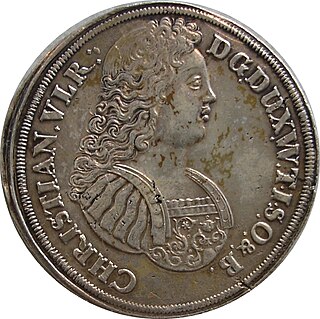 W
WDuke Christian Ulrich I of Württemberg-Oels was a German nobleman. He was the ruling Duke of Württemberg-Bernstadt from 1669 to 1697 and then the ruling Duke of Oels-Württemberg from 1697 until his death.
 W
WRudolf Hieronymus Eusebius von Colloredo-Waldsee, born 2 November 1585 in České Budějovice, Kingdom of Bohemia, was a Bohemian nobleman and the brother of Hieronymus von Colloredo-Waldsee. A member of the Colloredo family, he distinguished himself in the Thirty Years' War, especially at the Battles of Mantua and Lützen. Emperor Ferdinand III appointed him to the Imperial Privy Council and named him a Field Marshal. Although unable to prevent Prague Castle from falling to Sweden's Hans Christoff von Königsmarck, Colloredo-Waldsee's bold defense of Prague's old town halted the Swedish invasion of Bohemia on 26 July 1648 and saved the Habsburg's ancestral lands in Austria. After the war, he built the Schönborn Palace in Prague home to the United States Embassy to the Czech Republic. He died in Prague on 24 February 1657.
 W
WJohn Amos Comenius was a Czech philosopher, pedagogue and theologian from the Margraviate of Moravia who is considered the father of modern education. He served as the last bishop of the Unity of the Brethren before becoming a religious refugee and one of the earliest champions of universal education, a concept eventually set forth in his book Didactica Magna. As an educator and theologian, he led schools and advised governments across Protestant Europe through the middle of the seventeenth century.
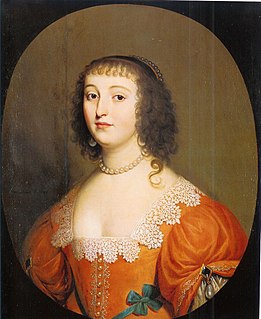 W
WElisabeth of the Palatinate, also known as Elisabeth of Bohemia, Princess Elisabeth of the Palatinate, or Princess-Abbess of Herford Abbey, was the eldest daughter of Frederick V, Elector Palatine, and Elizabeth Stuart. Elisabeth of the Palatinate was a philosopher best known for her correspondence with René Descartes. She was critical of Descartes' dualistic metaphysics and her work anticipated the metaphysical concerns of later philosophers.
 W
WJuan de Esteyneffer was a Moravian German lay Jesuit missionary sent to the New World. He is known for his 1711 work Florilegio Medicinal, which compiled a combination of New World traditional medicine, European materia medica, and 18th-century European medical diagnosis.
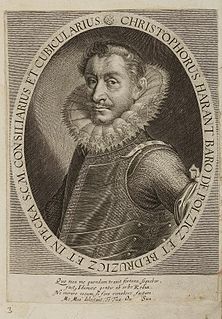 W
WKryštof Harant of Polžice and Bezdružice was a Czech nobleman, traveler, humanist, soldier, writer and composer. He joined the Protestant Bohemian Revolt in the Lands of the Bohemian Crown against the House of Habsburg that led to Thirty Years' War. Following the victory of Catholic forces in the Battle of White Mountain, Harant was executed in the mass Old Town Square execution by the Habsburgs.
 W
WWenceslaus Hollar was a prolific and accomplished Bohemian graphic artist of the 17th century, who spent much of his life in England. He is known to German speakers as Wenzel Hollar; and to Czech speakers as Václav Hollar Czech: [ˈvaːtslav ˈɦolar]. He is particularly noted for his engravings and etchings. He was born in Prague, died in London, and was buried at St Margaret's Church, Westminster.
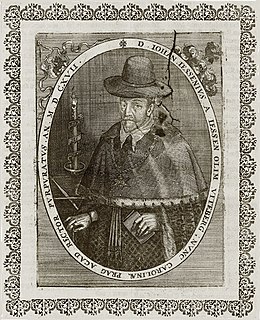 W
WJan Jesenius, also written as Jessenius, was a Bohemian physician, politician and philosopher.
 W
WGeorg Joseph Kamel was a Jesuit missionary, pharmacist and naturalist known for producing the first comprehensive accounts of Philippine flora and fauna and for introducing Philippine nature to the European learned world. A number of Kamel's treatises were published in the Philosophical Transactions, while his descriptions of Philippine flora appeared as an appendix to the third volume of John Ray's Historia Plantarum.
 W
WJakub Kresa, Spanish: Jacobo Kresa, Latin: Jacobo Kreysa was one of the most important Czech mathematicians of the Baroque era.
 W
WAnna Aloysia Maximiliane Louise von Lamberg was an Austrian countess who was successively the mistress of Augustus II the Strong, King of Poland, and Aleksander Benedykt Sobieski. She is known to history as Countess Esterle.
 W
WLouise Hollandine of the Palatinate was a painter and abbess. She was a daughter of Frederick V of the Palatinate and King of Bohemia, and Elizabeth Stuart.
 W
WJan Mydlář (1572–1664) was a 17th-century executioner from Bohemia. He is mostly known for his performance of the 1621 execution of 27 Bohemian Revolt leaders, and is remembered by his red hood-like mask he donned when performing his executions.
 W
WCharlotte of the Palatinate, was the fourth daughter of Frederick V, Elector Palatine, the "Winter King" of Bohemia, by his consort, the English princess Elizabeth Stuart. Charlotte was born in the Dutch Republic, where her family had sought refuge after the sequestration of their Electorate during the Thirty Years' War. Charlotte's brother Charles Louis was, as part of the Peace of Westphalia, restored to the Palatinate.
 W
WPolyxena of Lobkowicz was a politically active Czech noble and styled Princess of the House of Lobkowicz. She played an important role as the channel between the noble families of Bohemia and the Imperial court in Vienna through her good connection with the Spanish envoy during the counter reformation in Bohemia after 1618.
 W
WCarl von Rabenhaupt was a Bohemian Hussite nobleman who fought in Saxon, Dutch and Hessian service during the Thirty Years War and came out of retirement to command a Dutch regiment in the Franco-Dutch War.
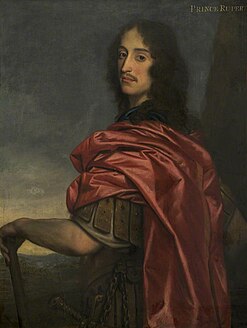 W
WPrince Rupert of the Rhine, Duke of Cumberland, was a German-English army officer, admiral, scientist and colonial governor. He first came to prominence as a Royalist cavalry commander during the English Civil War. Rupert was the third son of the German prince Frederick V of the Palatinate and Elizabeth, eldest daughter of James VI of Scotland and I of England.
 W
WJiří Rychnovský was a Czech composer of the Renaissance and early Baroque era. He was the mayor of Chrudim. His musical work consists of Czech and Latin sacred music with advanced vocal polyphony, revealing a knowledge of European designs, but also the efforts of self-expression. His compositions have been recorded in manuscripts of the Literary Society in St. Michael in New Town in Prague. It is one of the few surviving complete collections of Czech Renaissance sacred music. He usually wrote under his Latin name Georgius Rychnovinus.
 W
WKarel Škréta Šotnovský ze Závořic (1610-1674) was a Czech portrait painter who worked in the Baroque style.
 W
WVilém Slavata z Chlumu a Košumberka was a Czech nobleman from old Bohemian family. As viceregent (místodržící) of Emperor Ferdinand II of Habsburg he became famous as co-victim, along with Jaroslav Borzita of Martinice, of the 1618 Defenestration of Prague.
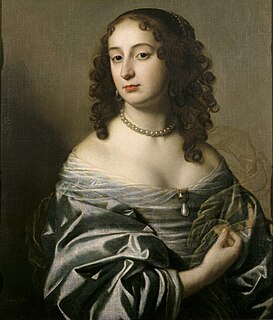 W
WSophia, Electress of Hanover was the Electress of Hanover by marriage to Elector Ernest Augustus, and later the heiress presumptive to the thrones of England and Ireland under the Act of Settlement 1701. She died less than two months before she would have become queen. Consequently, it was her son George I who succeeded her first cousin once removed, Anne.
 W
WAnton Stevens was a Bohemian painter active in the second third of the 17th century. Besides Karel Škréta he was another important promoter of early Baroque painting in the country.
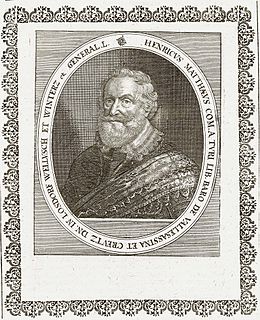 W
WCount Jindřich Matyáš Thurn-Valsassina, was a Czech (Bohemian) nobleman, one of leaders of Protestant Bohemian Revolt against Emperor Ferdinand II. He took part in events that led to the Thirty Years War, and after the war he became a military leader and diplomat in Swedish service, who eventually resided in Swedish Estonia.
 W
WPavel Josef Vejvanovský was a Czech-Moravian composer and trumpeter of the Baroque period.
 W
WAlbrecht Wenzel Eusebius von Wallenstein, also von Waldstein, was a Bohemian military leader and statesman who fought on the Catholic side during the Thirty Years' War (1618–1648). His successful martial career made him one of the richest and most influential men in the Holy Roman Empire by the time of his death. Wallenstein became the supreme commander of the armies of the Habsburg Emperor Ferdinand II and was a major figure of the Thirty Years' War.
 W
WCount Johann Wenzel Wratislaw von Mitrowitz was the Chancellor of Bohemia.